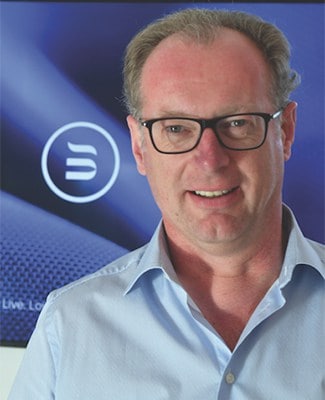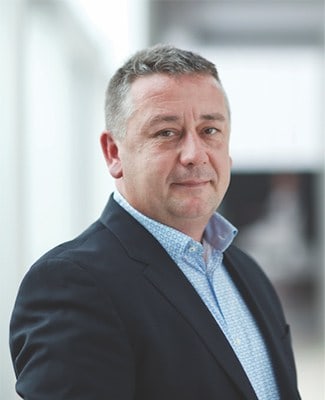BY GARY JAMES
Textile supplier has wider global reach, plus a mandate for innovation and customer service

PRODUCT SHOWCASE A group of product designers gathers to review designs in BekaertDeslee’s new pop-up fabric ‘store’ at its headquarters in Waregem, Belgium.
With the hard work of integrating two broad product lines, individual sales and management teams, and complex production and distribution networks now complete, BekaertDeslee enters 2018 with momentum. Its ambitious plans include expanding its global presence in its longtime niche of woven and knitted mattress textiles and sewn, or zippered, mattress covers.
The merger of Bekaert with DesleeClama, which took place in January 2016, brought together two venerable textile manufacturers that both started in the village of Vichte, Belgium: Bekaert Textiles, founded by Ivo Bekaert in 1892, and Deslee Textiles, founded by Maurice Deslee in 1928. At the time of the merger, both companies specialized in high-quality, fashion-forward fabrics for bedding use, and both companies were longtime exporters to the United States and other global markets. Bekaert Textiles started exporting to the United States in the 1930s, then expanded its presence by establishing Bekaert Textiles USA, along with a domestic production facility, in 1999. Deslee Textiles entered the U.S. market in 2002, when it founded Deslee USA and opened a factory in Inman, South Carolina. It became DesleeClama in 2004, when it acquired competitor Clama from the Clarys family.
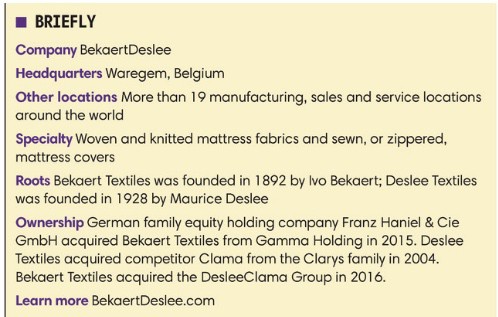
“Our mattress textiles touch 600 million sleepers every night,” says Hans Dewaele, chief commercial officer for BekaertDeslee. “We are the largest mattress textile producer in the world, and we have a leading position in almost all the global markets where we do business.”
The combination of Bekaert and DesleeClama creates a customer-oriented company with a large global footprint, enhanced service capabilities and a comprehensive product portfolio, Dewaele says, adding that the merger was fueled by the increasing awareness of the importance of sleep and the acceleration of the global mattress market.
“Our customers are becoming more global. With our network of production facilities throughout the world, we are in a unique position to serve global producers and local markets in a very cost-efficient way,” he says. “We can offer all our customers highly innovative designs, as well as fast, reliable service.”
Dewaele says there was little overlap in facilities when Bekaert and DesleeClama merged. For instance, DesleeClama was active in Brazil, while Bekaert was strong in Argentina and Mexico. DesleeClama had a strong presence in southern China and Indonesia; Bekaert was focused on northern China and Australia. Both companies, however, were strong in Europe and the United States. “The two companies fit together in a very complementary manner,” Dewaele says.
Reflecting its commitment to the U.S. market, which accounts for nearly one-third of all its sales globally, BekaertDeslee announced in September a major expansion of its manufacturing facility in Winston-Salem, North Carolina. The company is investing more than $4 million to add more than 80,000 square feet to its existing manufacturing footprint of 270,000 square feet. The expansion will include new knitting machinery and updated equipment to support the company’s weaving operations, along with an additional finishing frame and laminating machine.
“We are making this major investment to allow us to better service our growing customer base and the ongoing demand in this key North American market,” says Brandon Wells, general manager of BekaertDeslee USA. “This new machinery and square footage will increase our capacity significantly and provide us a much greater degree of flexibility.”
The expansion, set to be completed in early 2018, will add 50 employees to the current 250-person workforce in Winston-Salem. BekaertDeslee also continues to operate its facility in South Carolina, which now is used primarily as a finished goods warehouse and staging facility for raw materials used in U.S. production. The company also supports the U.S. market with two company-owned factories in Mexico, as well as a business office in Riverside, California.
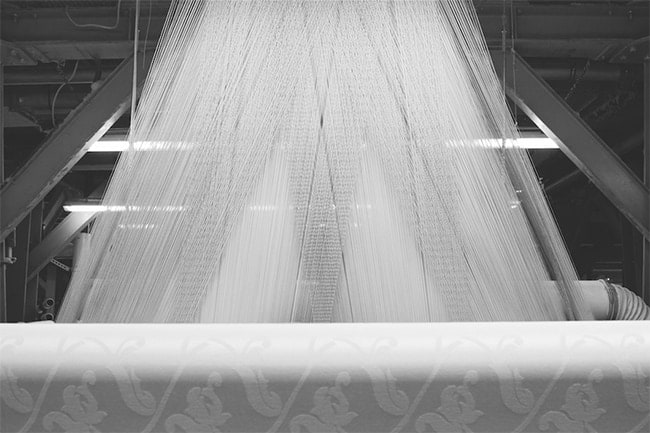
STILL WEAVING A loom in BekaertDeslee’s facility in Tekirdag, Turkey, weaves a traditional ticking design.
Creating unity
With two years having passed since the merger, Bekaert and DesleeClama are now a single, unified company with a clear mission to serve customers’ needs. The process of integrating their far-flung operations wasn’t easy, Dewaele says. “It took nearly a year just to get all our factory teams trained, and we’ve worked equally hard to get our technology and other systems integrated,” he says.
The assimilation process has touched every corner of the business, from design and production to sales and marketing.
In the fabric technology area, for example, BekaertDeslee has introduced Sleep Dimensions, a new range of products organized by six themes: Climate, which encompasses all fabrics with cooling properties; Clean, which addresses allergens, mold, bacteria and mites; Revive, a group of high-tech sleep surfaces with energy rejuvenation properties; Senses, a collection of soft, scented textiles; Support, which are flexible textiles that adapt to body shape; and Fit for Function, which include technologies for boxed mattresses and other custom solutions.
To simplify customers’ selection options, BekaertDeslee further differentiates its line by grouping designs into five styles (Classic, Fusion, Nuance, Plus and Pure) and 10 emerging trend collections, which evolve with the market. Recent trend collections include Vision, Intuition and Character, launched in November.
“In our new approach, we try to associate each of our designs with a ‘mood board’ or lifestyle,” Dewaele says. “It brings the fabrics to life and provides an easier way to sort through our very diverse line.”
A product selection tool is available on BekaertDeslee’s website that enables customers to quickly review the company’s line. More robust search capabilities also are featured on the BekaertDeslee Cloud.
In addition, BekaertDeslee recently unveiled a new space in its headquarters facility in Waregem, Belgium, that showcases its line in a setting much like a pop-up store. The airy, attractive presentation includes easy-to-view—and feel—hanging racks of fabrics organized by style, as well as mattress and pillow displays showcasing BekaertDeslee fabrics. The “store” is a resource for BekaertDeslee marketers, designers and sales representatives, as well as for customers, as they meet to review current designs or look for inspiration in the company’s archives of more than 100,000 designs developed by Bekaert and DesleeClama over the two companies’ long histories.
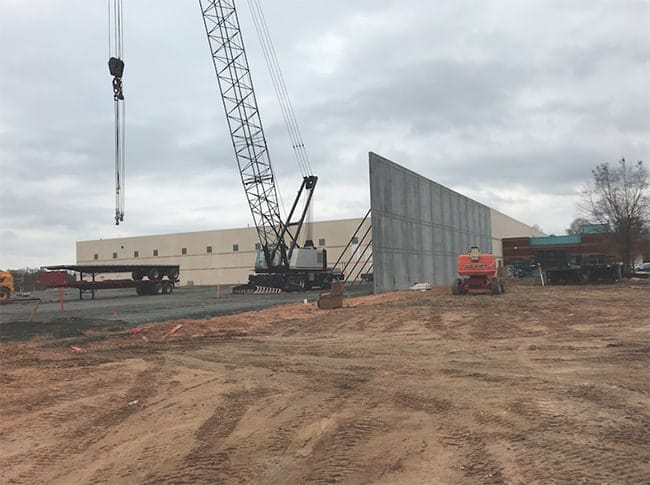
MAKING ROOM FOR MORE BekaertDeslee is adding 80,000 square feet to its production facility in Winston-Salem, North Carolina. The expansion is due for completion early this year.
Fostering innovation
At its headquarters, BekaertDeslee has a team of 24 designers and five marketers who support sales. Another 40 designers are based in its business offices throughout the world. The field designers are charged with creating designs targeted to local markets, as well as feeding ideas to the headquarters team for incorporation into the global product mix. In the United States, designers also work closely with mattress manufacturers’ product teams, which often have their own ideas for fabric designs. A 3-D configurator tool on the BekaertDeslee Cloud makes it easy for in-house designers and customers’ design teams to see how colors, patterns and trims will work together on different mattresses.
“There is a lot of cross-pollination of ideas and inspirations,” says Philip Ghekiere, marketing and design director for BekaertDeslee. “We combine the resources and global perspective of a large company with the local market knowledge and responsiveness of a smaller company.”
To position the unified BekaertDeslee in the marketplace, the company developed a new logo and an updated tagline: “Close to You.” Inspirational and aspirational, the tagline was designed to convey four themes. “First, the global footprint of our company—the fact that wherever you are, we’re not far away. Second, the fact that we are physically close to you with our products, which 600 million people sleep on every night,” Ghekiere says. “And third, that our philosophy is to work closely together with our customers to create products that meet consumers’ needs—not just to sell whatever it is we have on the shelf.”
The fourth aspiration, Ghekiere says, is to be “employee centric. We care for employees’ personal development and want them to connect and be proud of the company they work for.”
Reflecting its cooperative spirit, BekaertDeslee recently created the BekaertDeslee Academy, a platform for innovation between BekaertDeslee, customers, and the scientific and industrial research community. The academy provides a way for sleep products designers and manufacturers to share ideas with a network of other experts worldwide and collaborate on the development of products.
BekaertDeslee’s Respiro (Italian for “I breathe”) textile collection, for example, was created through the academy in partnership with Kreamat, a bed producer based in Bilzen, Belgium, and Stefan Schöning, a Belgian furniture designer. The winner of the Intelligent Material & Design Award at the 2017 Interzum show in Cologne, Germany, Respiro is a one-piece cover for adjustable beds that combines several technologies to enhance airflow and breathability. A 3-D structure ventilates the mattress and reduces pressure, a second technology regulates humidity and temperature, and a third technology helps keep Respiro clean.
As a result of the collaboration, Kreamat ended up with “a fantastic new bed that’s perfect for their line,” Ghekiere says, and BekaertDeslee gained a new high-tech fabric it can market to customers outside Belgium, where Kreamat will have an exclusive.
Ghekiere encourages all of the company’s customers to take advantage of the academy, providing they are willing to share their own innovations with partners. “We act as the coordinator, identifying which companies and research institutions might be a good fit for collaboration,” he says. Current partners include North Carolina State University and leading universities in Europe, as well as in Australia and Turkey.
- Brandon Wells
- Hans Dewaele
- Philip Ghekiere
Technology on the rise
Going forward, technology will play an ever-increasing role in BekaertDeslee’s product development. “Airflow management and temperature control are very important to quality sleep, and the cover needs to work hand in hand with a mattress to deliver the best experience possible,” Ghekiere says. “Humidity is another area that we address since a mattress can become very uncomfortable if it is cold or clammy.”
BekaertDeslee also offers a range of technologies with health, beauty and hygiene-enhancing properties. The most recent example is Skin+, a novel treatment for mattress and pillow fabrics that can help protect, regenerate and beautify skin, according to the company. Based on a patented probiotic technology, Skin+ puts the power of carotenoids—the organic pigments found in the skin of carrots and tomatoes—to work each night that a sleeper is in bed.
To back up its claims, BekaertDeslee works with leading independent labs and universities worldwide to develop objective data on performance. Skin+ is the outcome of a co-creation effort by BekaertDeslee Academy, Devan Chemicals and ProDigest, a biotech spinoff company of Ghent University in Ghent, Belgium.
Right now, two trends are driving the mattress industry, particularly in the United States, according to Ghekiere. At the medium to higher end of the market, there’s a move toward more individualization of sleeping comfort. For this segment, bed producers and suppliers are working to deliver mattresses and pillows that are “made for you and just for you,” Ghekiere says. “There’s great potential in this area as sleep science continues to progress and manufacturers’ ability to deliver custom products increases.”
At the same time, the U.S. market is seeing more demand for simple, affordable beds that can be shipped directly to the consumer. “These consumers don’t want to go to the store and try out their bed before they buy,” Ghekiere says. “They don’t want to spend a lot of time learning about different foams and covers. They just want to visit a website or two, place their order and have the bed sent directly to their home so they can start sleeping on it.”
Smoothing out wrinkles
While boxed-bed marketers aim to streamline shopping by limiting the range of products and features to a few basic models, the beds themselves have a set of complicated manufacturing requirements quite different from traditional mattresses. The beds must be capable of being compressed and rolled, and the fabrics that go on the beds need to be highly wrinkle resistant. To meet this demand, BekaertDeslee offers Smooth, a range of knitted mattress fabrics that show fewer wrinkles when unfolding, according to the company.
The boxed-bed segment quickly has gained a significant share of the U.S. market—10% or more, according to some estimates, but it’s hard to tell how big the segment will grow in the long term.
“It’s in the spotlight right now but that may fade over time,” Dewaele says. One plus of the category’s emergence, he adds, is that it has garnered media attention that, in turn, has focused consumers on “the importance of sleep to health, productivity and overall well-being.” While the boxed-bed trend is strongest in the United States, Dewaele expects more online specialists to emerge in Europe and other global markets.
When it comes to fabrics for boxed beds, cover designs tend to be less ornate than for other beds, which feature a wider range of colors, patterns and border ornamentation. For boxed beds, the rule of the day seems to be all-white, all-dark or the combination of a white panel with a crisp, dark border. “A detailed, ornate pattern won’t typically translate that well online,” Wells says. “But there’s a lot that can be done with color and trim, and we’re starting to see more interest in design as these boxed-bed specialists broaden their lines.”
For mattresses that aren’t sold in a box, the range of designs is much wider. Wells points to current trends that include more use of bold panel colors, creative mixes of colors, and coordinating gussets, border tapes and handles. “Gray also continues to be very popular and everyone is on the lookout for the ‘new’ gray,” he says. “There’s a lot of demand for tailored looks with lots of details, and with our ability to make borders, handles and tapes from our fabrics, we enable our customers to put complete, highly coordinated packages together.”
In the U.S. market, where mattress retailing is hyper-competitive, mattress fabrics play a key role in brand positioning and marketing, Wells says. “If you have 40 beds on a floor, the consumer needs visual cues to help them distinguish different brands and models,” he says. “Fabric is a big part of any successful mattress brand’s identity.”
Cut-and-sew convenience
In addition to being a one-stop shop for fabrics and cover embellishments, BekaertDeslee offers cut-and-sew services. In North America, it provides cut-and-sew capabilities as part of its 100,000-square-foot production facility in Tijuana, Mexico. It has a similar operation at its fabric plant in Ixtacuixtla, Mexico, for customers in Latin America and South America. The cut-and-sew operations manufacture sewn mattress covers, point-of-sale items for top of bed, finished pillows and upholstered foundations.
“In recent years, we have invested heavily in state-of-the-art equipment and personnel to position ourselves as a leader for contract cut and sew,” Wells says.
While unfinished woven and knit mattress fabrics remain a cornerstone of BekaertDeslee’s business, sewn covers are driving more of the company’s current growth, Dewaele says. In 2018, the company will make further investments in its finishing capabilities to strengthen its position.
“Traditional companies are looking to outsource cut-and-sew work when they can,” Dewaele says, noting that, in addition to its facilities in Mexico, BekaertDeslee has a large cut-and-sew operation in Romania. “Cut-and-sew is already an important part of our business but, in the future, we see it becoming even more critical to our customers as they look for ways to cut costs and improve efficiencies,” he says.
BekaertDeslee also is a leading producer of mattress tapes in the Mexican marketplace. Taking advantage of its capabilities in Mexico, the company is planning to expand this line into the U.S. and Canadian markets this year.
As part of German family equity firm Franz Haniel & Cie GmbH, which acquired Bekaert from Gamma Holding in 2015, BekaertDeslee is well-positioned to continue expanding its presence in current—and new—markets. India is one likely candidate for expansion. Further acquisitions also are a possibility.
“We will continue to look for opportunities to grow globally and also to expand our abilities to service our customers with the products and solutions they need to be successful,” Dewaele says.





